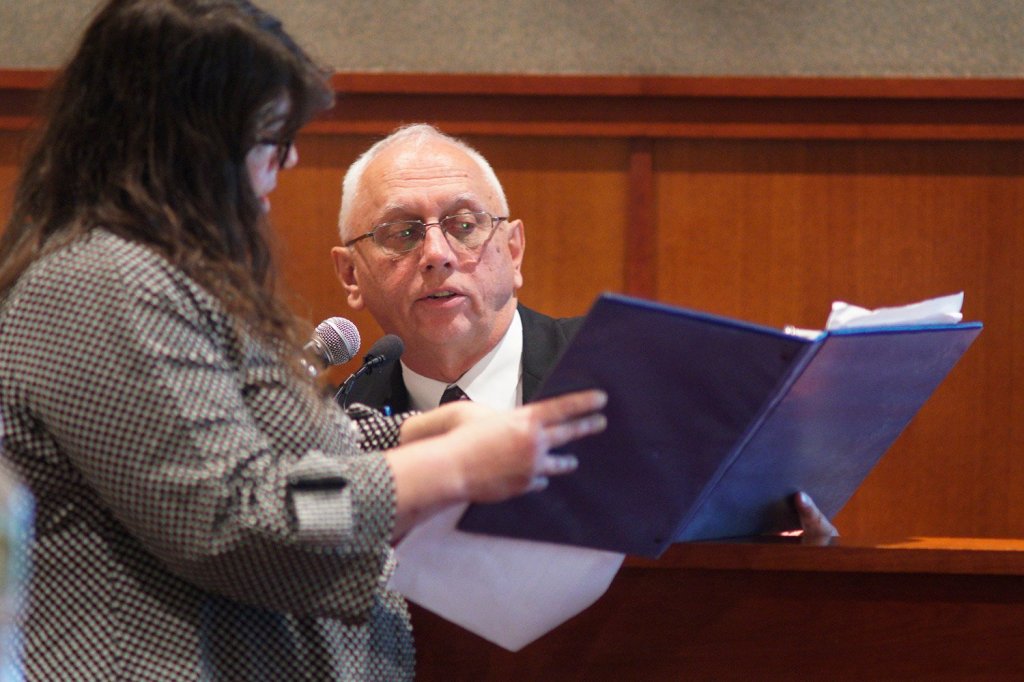Attorneys for convicted murderer Anthony H. Sanborn Jr. on Wednesday questioned a retired Portland Police detective about whether the police adequately pursued alternate suspects during the investigation into the 1989 murder of 16-year-old Jessica L. Briggs.
Retired police detective James Daniels returned to the witness stand Wednesday, and was questioned by one of Sanborn’s attorneys, Amy Fairfield, about multiple people who could also have had an opportunity to kill Briggs.
The day of testimony played out methodically, although the tension between Fairfield and Assistant Attorney Generals Paul Rucha and Meg Elam, who are fighting to preserve Sanborn’s conviction, grew visible.
At one point, Fairfield appeared to ask Rucha to stop interjecting comments or references when she was asking questions. Fairfield responded to an inaudible comment by Rucha, and they argued in a whisper as Justice Joyce Wheeler waited.
“Don’t take that tone with me, please,” Rucha was heard saying to Fairfield, before both attorneys moved on.
Daniels testified that he interviewed a man named Karl Gee, who said he spoke with another person named David who told him he witnessed the murder.
The person named David told Gee that he knew who killed Briggs — a third man who went by “Butch,” according to testimony Wednesday.
Daniels said investigators were aware of someone who went by “Butch,” a man named Morris King. With detectives, Gee helped form a composite sketch of David.
In his notes, Daniels had a photograph of someone named “D.W. Collins,” along with a notation, “David Collins, regarding Karl Gee report.” Daniels said the composite developed to identify Collins was not turned over to defense attorneys, and he was not sure whether Collins’ last name was turned over either.
“Do you remember seeing anything in a report about David Collins?” Fairfield asked.
“I’m not sure,” Daniels said. “I don’t know, I don’t remember.”
Another potential suspect was a man believed to have been walking near Jessica when she and a boy with a bike strolled down the Maine State Pier, where she was later brutally killed.
At the time in 1989, Bath Iron Works operated a dry dock facility on the Maine State Pier, where police and prosecutors believe she was murdered.
At that time, BIW chartered a bus that took third-shift workers from the Portland facility back to Bath. The bus waited near the pier each night around midnight, around the time Briggs was believed to have walked by.
The driver of the bus worked with police to develop a sketch of a man he reported seeing walking about six feet ahead of Briggs as she disappeared behind a gate toward the pier.
The man’s sketch was never released publicly at the time, but was discovered in the two boxes of case files Daniels kept at his home for nearly two decades, along with other composite sketches.
Daniels resisted using the terms “suspect” and “person of interest” to describe the man, and said he does not know if he was ever identified.
“The investigation took us in another direction. We were looking at other people,” Daniels said.
Fairfield also turned her attention to a man whom Sanborn’s original defense team sought to identify as an alternate suspect — Scott Knoll.
At trial, Knoll said that on the night before the murder, he left Peppermint Park before midnight. But in an interview with police where Knoll explained the timeline of his own whereabouts, Knoll said he got home about 1:45 a.m.
Daniels hesitated to use the terms “rule in” and “rule out” to describe Knoll, and said to determine the answer, he would have to “look at the whole thing in its entirety.”
Fairfield asserted that the alternate, later time frame for Knoll’s return home was not noted in a report that was handed over to the defense.
When asked about the conflicting trial testimony of the time-frames that could have meant Knoll was not at home when Briggs was killed, Daniels, who sat with prosecutors throughout the trial, said he did not think it was his role to jump up and object when sworn testimony seemed incorrect.
“My role at the prosecution’s table is not to intently listen to everything,” he said. “I could have been looking at a file, I could have been doing any number of things. I’m not a practicing attorney, it’s not my role.”
Fairfield shot back: “Is it your role to make sure the right person was convicted of murder?”
“Of course,” Daniels said.
“Is it your role to document what witnesses say in a report?” she asked.
“Yes,” he said.
“Did you document that in a report?” Fairfield replied.
“I don’t know,” Daniels said.
Matt Byrne can be contacted at 791-6303 or at:
Send questions/comments to the editors.




Success. Please wait for the page to reload. If the page does not reload within 5 seconds, please refresh the page.
Enter your email and password to access comments.
Hi, to comment on stories you must . This profile is in addition to your subscription and website login.
Already have a commenting profile? .
Invalid username/password.
Please check your email to confirm and complete your registration.
Only subscribers are eligible to post comments. Please subscribe or login first for digital access. Here’s why.
Use the form below to reset your password. When you've submitted your account email, we will send an email with a reset code.